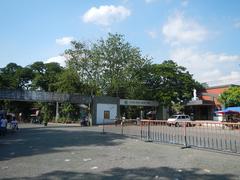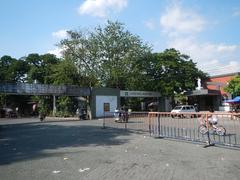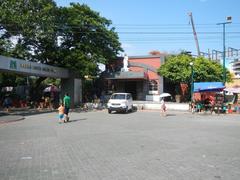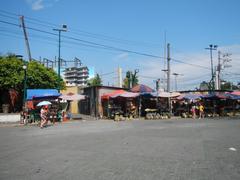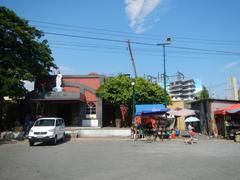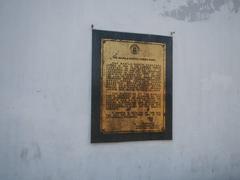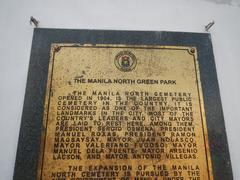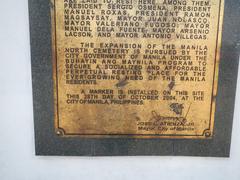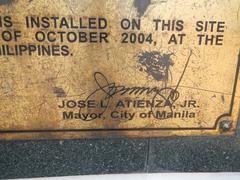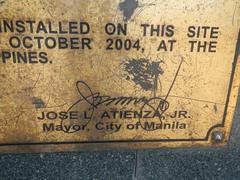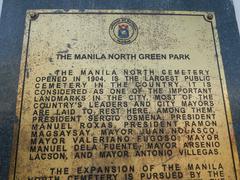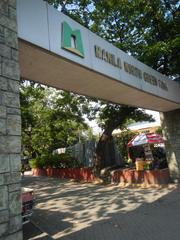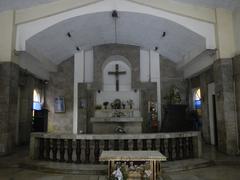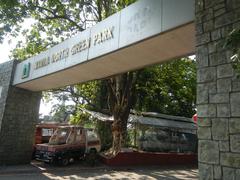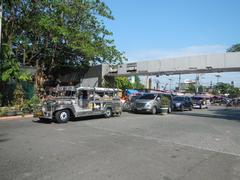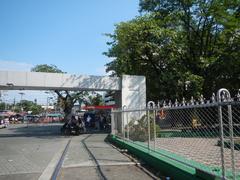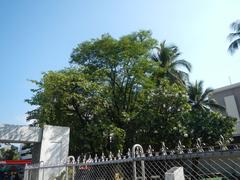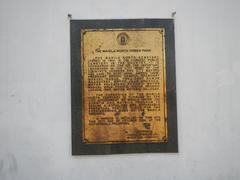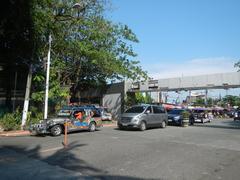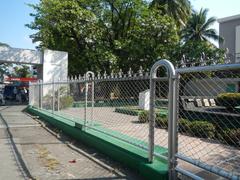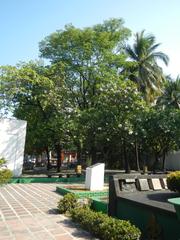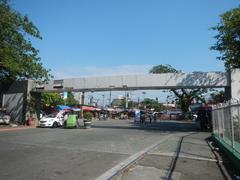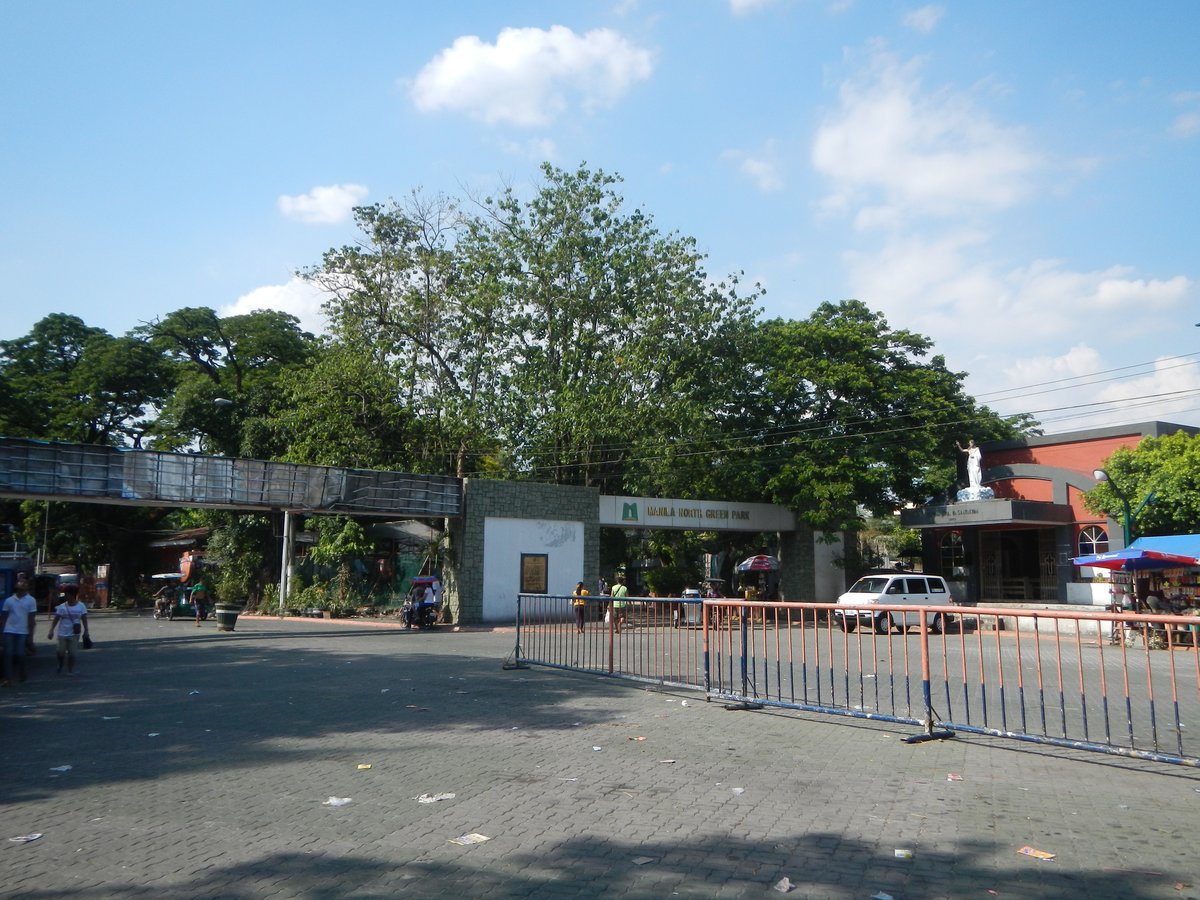
Manila North Cemetery Visiting Hours, Tickets, and Historical Sites Guide
Date: 14/06/2025
Introduction to Manila North Cemetery
Manila North Cemetery, established in 1905 during the American colonial period, is Metro Manila’s largest and most historically significant necropolis, covering approximately 54 hectares. As the final resting place of presidents, national artists, revolutionaries, and public servants, it offers a unique window into the Philippines’ evolving social fabric, architecture, and urban life (Wikipedia; NHCP). The cemetery’s landscape features an eclectic blend of architectural styles, from Art Deco and Neoclassical to vernacular Filipino designs, reflecting both colonial influences and local adaptations (BluPrint; Inquirer).
Uniquely, Manila North Cemetery is also home to a vibrant community of informal settlers who live and work within its grounds, creating a dynamic coexistence of life, memory, and heritage (Lonely Planet). The cemetery’s proximity to other landmarks such as La Loma Church, the Chinese Cemetery, and Paco Park further cements its role as a vital component of Metro Manila’s historical landscape.
Table of Contents
- Introduction
- Visiting Manila North Cemetery
- Historical Background and Architectural Styles
- Notable Graves and Memorials
- Visitor Experience and Cultural Practices
- Practical Information and Safety Guidelines
- Frequently Asked Questions (FAQs)
- Conclusion and Call to Action
- References and Further Reading
Visiting Manila North Cemetery
Visiting Hours
- Regular Hours: Open daily, typically from 6:00 AM to 6:00 PM. Some sources note opening as early as 5:00 AM and closing at 5:00 PM (Newspapers.ph).
- Undas (All Saints’ and All Souls’ Days): Visiting hours may be extended to accommodate crowds. Confirm with official sources or local government announcements before visiting during these peak periods.
Entrance Fees and Tickets
- Admission: Entry is free for all visitors.
- Tours: Some guided heritage tours (e.g., Old Manila Walks) may charge a fee. Check with tour operators or tourism offices for updated rates and schedules.
Accessibility and Travel Tips
- Location: Santa Cruz district, Manila; adjacent to the Manila Chinese Cemetery and La Loma Church.
- Getting There: Easily accessible via jeepneys, buses, and taxis. The Blumentritt LRT station is a 15-minute walk away.
- On-Site Mobility: The cemetery features wide avenues but also uneven and narrow paths. Wear comfortable footwear and consider bringing an umbrella or hat for sun protection.
- Assistance: During peak seasons (e.g., Undas), free e-trike rides assist seniors, persons with disabilities, and pregnant women.
On-Site Facilities and Amenities
- Restrooms: Basic public toilets are available near main entrances. Bring personal hygiene items for convenience.
- Food and Drinks: Sari-sari stores and vendors operate on ordinary days, but are restricted during major holidays—bring your own water and snacks during Undas.
- Seating and Shade: Limited benches and shaded areas; sun protection is recommended.
Nearby Attractions
- Manila Chinese Cemetery: Known for ornate temples and unique mausoleums (Spot.ph).
- La Loma Church: A heritage church nearby.
- San Sebastian Basilica and Intramuros: Easily accessible for those wishing to expand their heritage tour.
Guided Tours and Photography
- Tours: Local heritage groups and tour operators offer guided walks focusing on history, architecture, and notable burials. Book through the Manila City Tourism Office or reputable providers.
- Photography: Allowed for personal use. Maintain respect—ask permission before photographing people or private mausoleums, and avoid intrusive behavior.
Historical Background and Architectural Styles
Origins and Development
Manila North Cemetery, originally part of the larger La Loma Cemetery, was established as a non-sectarian, municipally owned burial ground in 1905 (Wikipedia; Vigattin Tourism). Its creation was driven by public health policies of relocating cemeteries outside city centers, a shift that began in the Spanish colonial era and was reinforced under American rule (NHCP; OpenEdition).
Architectural Highlights
The cemetery’s landscape is a showcase of funerary architecture:
- Art Deco: Mausoleums like Nakpil-Bautista, featuring geometric motifs (Inquirer).
- Neoclassical and Revivalist: Grand family plots with classical columns and pediments.
- Eclectic and Vernacular: Unique blends of Western and Filipino motifs.
Notable structures include the Mausoleo del los Veteranos de la Revolucion, honoring veterans of the Philippine Revolution and Philippine-American War (NHCP), as well as mausoleums for prominent families and community groups.
Socioeconomic and Cultural Context
The diversity of mausoleum styles—from grand monuments to modest graves—reflects Manila’s social stratification and evolving tastes (BluPrint). The presence of informal settlers, estimated at several thousand, adds a living, contemporary dimension to the heritage site (Lonely Planet).
Wartime History and Memorialization
During World War II, Manila North Cemetery was the site of mass executions by Japanese forces, and memorials within the grounds honor those who perished (NHCP). Notable martyrs include Josefa Llanes Escoda, Gen. Vicente Lim, and Rafael Roces (Spot.ph).
Preservation and Advocacy
Despite pressures from urban development, the cemetery retains much of its historic character, thanks to ongoing efforts by the administration and heritage advocates (OpenEdition).
Notable Graves and Memorials
Presidential Mausoleums
- Sergio Osmeña (4th President): Simple and dignified resting place (INQUIRER.net).
- Ramon Magsaysay (7th President): Memorial to a beloved populist leader.
- Manuel Roxas (5th President): Marked by a stately monument.
National Artists and Cultural Icons
- Amado V. Hernandez: National Artist for Literature, labor leader.
- Honorata “Atang” de la Rama: National Artist for Theater and Music.
- Fernando Poe Jr.: National Artist for Cinema and beloved film icon. (INQUIRER.net)
Political Leaders and Public Servants
- Former Manila Mayors: Including Antonio Villegas, Valeriano Fugoso, Arsenio Lacson, Juan Nolasco, and Manuel dela Fuente.
- Senators: Mariano Cuenco, Genero Magsaysay, Quintin Paredes, Claro M. Recto. (INQUIRER.net)
War Heroes and Martyrs
- World War II Martyrs: Memorials honor Josefa Llanes Escoda, Gen. Vicente Lim, Rafael Roces, and many unnamed casualties.
Heritage Mausoleums and Architectural Landmarks
- Family Mausoleums: Arroyo family’s pyramid mausoleum, Nakpil-Bautista, and others showcase intricate design and historical artistry.
- Chong Hock Temple: In the adjacent Chinese Cemetery, reflecting cultural diversity (Spot.ph).
Visitor Experience and Cultural Practices
Undas (All Saints’ and All Souls’ Days)
The cemetery becomes a vibrant gathering place as families honor ancestors with prayers, flowers, and offerings. The atmosphere is both festive and reverent, blending Catholic and indigenous Filipino traditions (Pinoy Builders).
Heritage Tours and Educational Walks
Guided tours offer insights into historical figures, architectural styles, and cultural practices. Book in advance, especially during holidays (Spot.ph).
Photographic Spots
Capture images of grand mausoleums, central avenues, and community life. Use descriptive alt text with keywords like “Manila North Cemetery visiting hours” and “Manila historical sites” for accessibility and SEO.
Practical Information and Safety Guidelines
Getting There and Entry Information
- Location: Santa Cruz, Manila.
- Transport: Jeepneys, buses, taxis; 15-minute walk from Blumentritt LRT.
- Entry: Free for all visitors; vehicle access restricted during major holidays (Spot.ph).
Safety Guidelines and Prohibited Items
- General Conduct: Dress modestly, be respectful, and avoid loud behavior.
- Prohibited during Undas: Alcohol, gambling items, sharp objects, firecrackers, sound systems, large tents, pets, bicycles (Newspapers.ph).
- Face Masks: Optional, but advisable in crowded settings.
Emergency Contacts and Assistance
- Security and first aid stations are present during holidays.
- Report lost items to the administration office near the main entrance.
Frequently Asked Questions (FAQs)
Q: What are the visiting hours?
A: Generally from 6:00 AM to 6:00 PM (some sources note 5:00 AM to 5:00 PM); check for updates during holidays.
Q: Is there an entrance fee?
A: No, entry is free.
Q: Are guided tours available?
A: Yes, through local heritage groups and tour operators.
Q: Is the cemetery accessible for persons with disabilities?
A: Accessibility is limited; free e-trike rides are available during peak periods.
Q: Can I take photographs?
A: Yes, but do so respectfully and seek permission before photographing people or private mausoleums.
Q: Are there restrooms?
A: Yes, but facilities are basic.
Q: Are pets allowed?
A: No, pets are not permitted, especially during holidays.
Q: What are nearby attractions?
A: Manila Chinese Cemetery, La Loma Church, San Sebastian Basilica, Intramuros.
Conclusion and Call to Action
Manila North Cemetery is a profound testament to Philippine history, culture, and resilience. Its notable burials, diverse architecture, and dynamic community life offer a rich, multidimensional visitor experience. To make the most of your visit, plan ahead, observe respectful conduct, and consider joining a heritage tour for deeper insight.
For enhanced exploration, download the Audiala app for interactive maps and guided audio tours. Follow us on social media for updates on events, tours, and historical features. Manila North Cemetery is not just a burial ground—it’s a living chapter of Manila’s story, waiting to be experienced and honored.
References and Further Reading
- Wikipedia
- NHCP
- OpenEdition
- BluPrint
- Inquirer
- Vigattin Tourism
- Lonely Planet
- Spot.ph
- Newspapers.ph
- INQUIRER.net
- Pinoy Builders
- Audiala
Additional reading:
